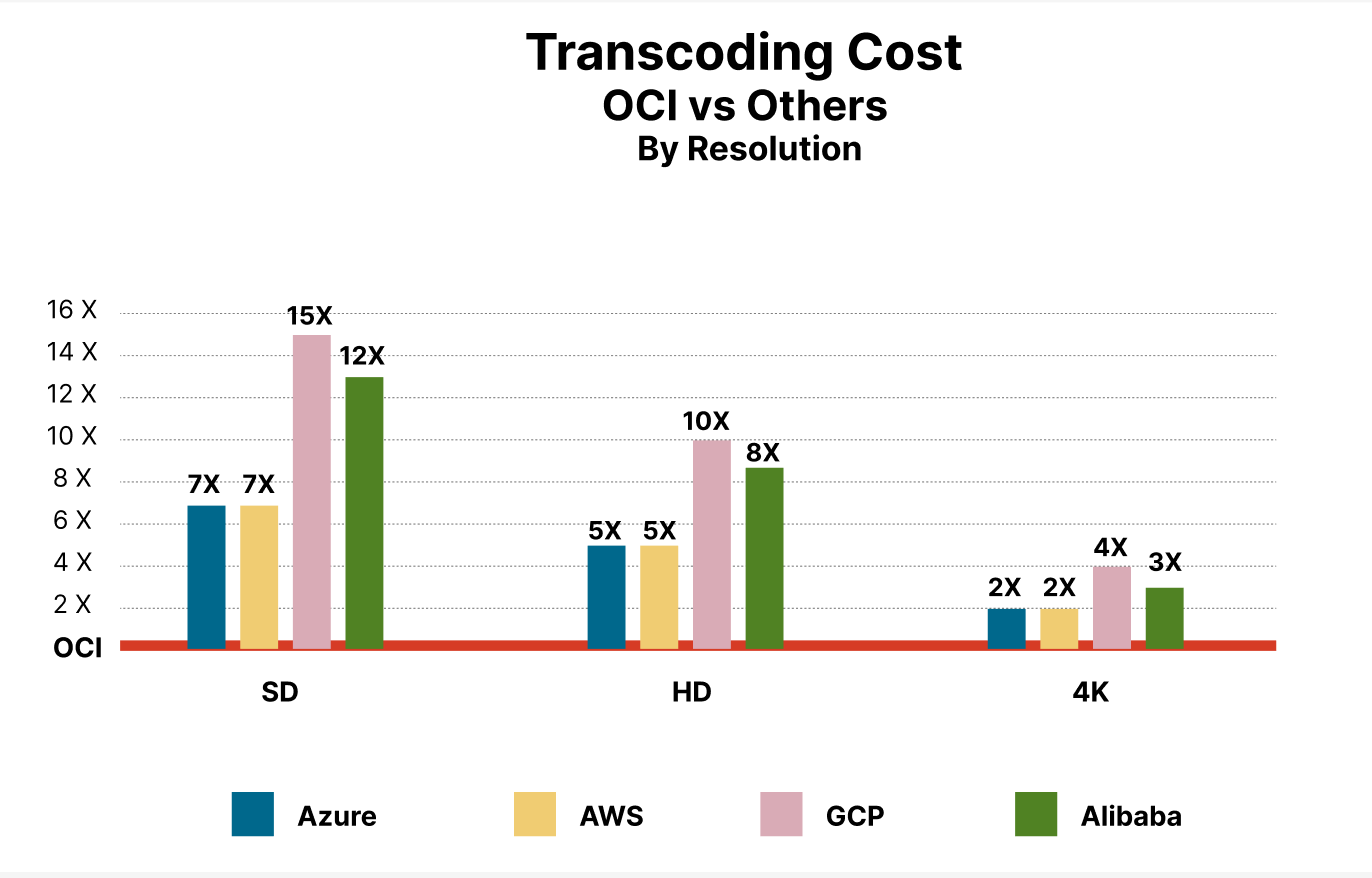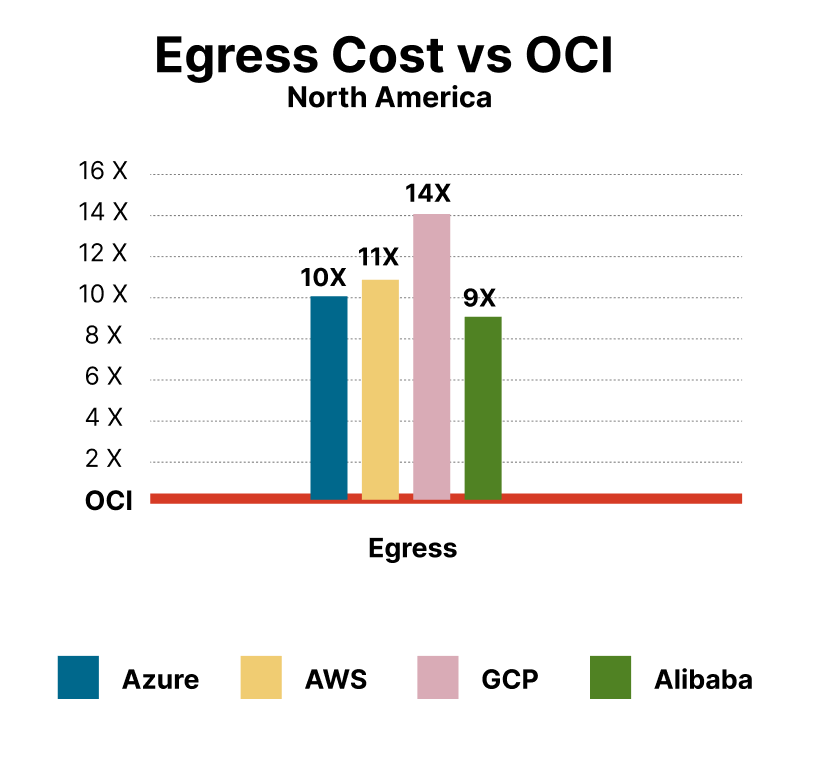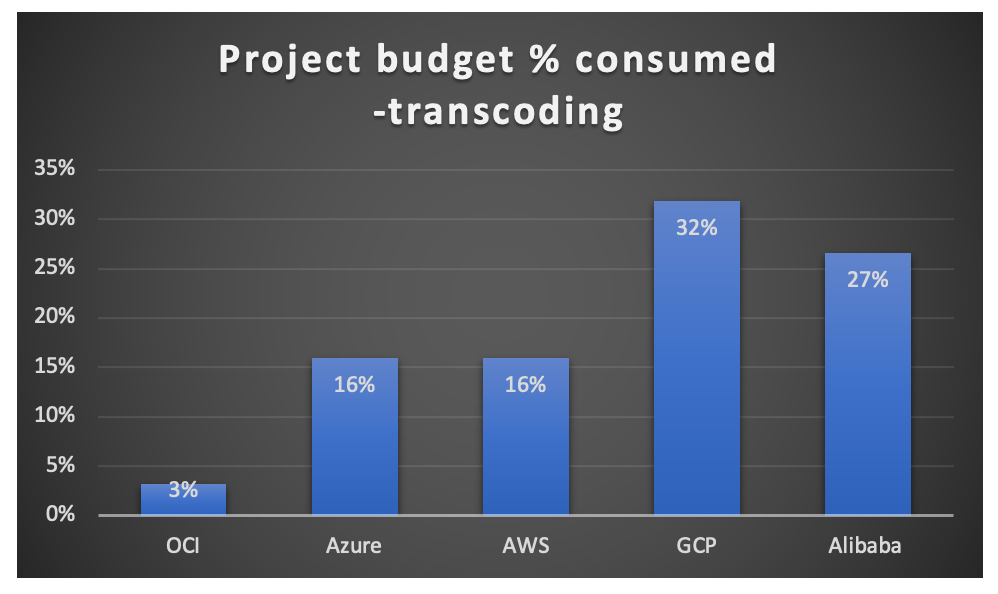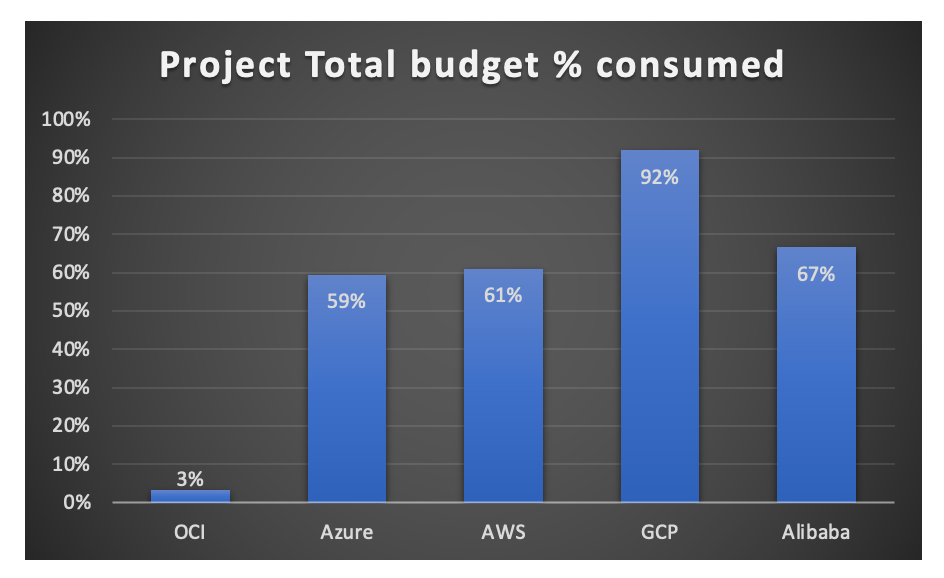As the demand for media content continues to soar, businesses in the media and entertainment industry are increasingly turning to cloud platforms to store, process, and distribute their content efficiently. Cloud providers like Amazon Web Services (AWS), Oracle Cloud Infrastructure (OCI), Microsoft Azure, Google Cloud Platform (GCP), and Alibaba Cloud offer a range of media services to meet the unique requirements of media-centric workflows. However, understanding the pricing models and cost factors involved can be challenging.
Key considerations for price comparison
In this blog post, we conduct a comprehensive price comparison of media services across these major cloud providers, shedding light on the cost considerations for businesses in the media industry. We also take a sample project with videos to compare the costs and benefits of using OCI.
You have two key costs associated when transcoding your videos in the cloud: Transcoding and data transfer costs. We largely analyze the pricing models for media file transcoding and assess how the costs vary based on factors such as file formats, video resolutions, bitrates, and processing requirements. Transmitting media content between services, regions, or to end-users can incur data transfer costs. We assess the pricing models for inbound and outbound data transfer and examine any potential cost-saving options.
We aim to provide businesses in the media industry with a comprehensive price comparison of media services across major cloud providers: AWS, OCI, Azure, and GCP. By examining the pricing models and cost factors associated with transcoding and data transfers, we empower organizations to make informed decisions about their cloud provider of choice based on their specific requirements and budget considerations. Stay tuned to unlock insights into optimizing media service costs and maximizing value in the cloud.
We’re comparing the following major cloud providers’ services to assess which is the most cost-effective solution:
| OCI | AWS | Azure | Alibaba | |
|---|---|---|---|---|
| Media Flow | Media Convert | Media Services Encoding | Transcoder API | AsparaVideo Media Processing |
Transcoding costs comparison
The following image compared the per-minute pricing on OCI against the others’ pricing

The graph represents the cost comparison for video transcoding services among the five major cloud providers. The cost scale is rationed based on OCI’s pricing for each transcoding resolution.
All the providers are at least twice the cost of OCI for 4K resolution. For HD resolution, it’s at least five times more than OCI, and as much as 15 times more for SD resolution.
This graph shows the significant cost advantages that OCI offers over its competitors for video transcoding services, making it an appealing choice for budget-conscious users seeking high-quality video processing without breaking the bank.
Data transfer
The egress from cloud provider plays important role especially in media streaming as the videos can be large. The Data transfer into cloud provider is usually free for customers.
OCI stands out as the unrivaled leader in providing cost-effective data transfer solutions among major cloud providers. OCI offers 10 TB per month free, while the other cloud providers compared here provide 100 GB per month. With an astounding free outbound network data transfer compared to its competitors, OCI demonstrates its commitment to empowering users with exceptional cost savings.
But OCI’s advantages don’t stop there. Even beyond the generous free allocation, OCI’s pricing for extra outbound network data transfer remains unparalleled. For North America, at just $0.0085 per GB, it boasts the lowest cost in the industry. For comparison, Azure charges $0.0870 per GB, AWS charges $0.0900 per GB, Google charges $0.1200 per GB, and Alibaba charges $0.08 per GB for extra data transfer.

This incredible combination of abundant free outbound data transfer and the most competitive pricing for more usage solidifies OCI’s position as the premier choice for users seeking a cloud platform that not only offers vast free data transfer but also ensures the lowest costs for more usage. Whether you’re a business with high data transfer requirements or an individual with data-intensive applications, OCI’s unbeatable pricing model makes it the smartest and most economical choice for all your cloud infrastructure needs.
Let’s review this information with real time data for a small project in the next section.
The Toony video project: A sample project
Welcome to the world of Toony, a cutting-edge video transcoding project that aims to revolutionize the way videos are delivered and accessed. With a primary focus on transcoding a diverse set of videos, spanning from crystal-clear 4K resolution to high definition (HD), Toony aims to optimize video streaming through the power of HTTP live streaming (HLS) playlists.
In an era where seamless and high-quality video streaming has become a necessity, Toony stands out as a cost-efficient solution that strives to achieve unparalleled performance while adhering to a budget of $100. Our team of skilled engineers and developers are challenged to create a sophisticated system that guarantees the smooth transcoding of videos, ensuring they’re perfectly adapted for various devices and internet connections. Each team is guided to pick one of the listed cloud vendors and granted $100 to review the expenses.
By harnessing the power of HLS playlists, Toony enables adaptive streaming, allowing users to enjoy uninterrupted video playback even on limited bandwidths. The HLS format dynamically adjusts the quality of video streams based on the viewer’s network conditions, ensuring a fluid viewing experience without buffering or delays.
In our Toony project, a random media workload data set that is taken as sample to determine price against each cloud provider. Some of the source files are 4K and some are in HD with various bitrates. The size of the file indicates the physical disk space it occupies as in before its run-on competing transcoding services.
| Number of Files | FPS | Bitrate x duration | Width x Height | Each file Size | Total Size |
|---|---|---|---|---|---|
| 10 | 28 | 40 Mbps * 5 Minutes | 3840 x 2160 | 1.78 GB | 10.78 GB |
| 15 | 24 | 10 Mbps * 5 Minutes | 1920 x 1080 | 232.2 MB | 3.483 GB |
| 30 | 28 | 5 Mbps * 5 Minutes | 1280 x 720 | 67.1 Mb | 2.013 GB |
For the Toony project, the transcoding ladder mimics the following table. No upscaling is performed in any of the cases.
| Rungs |
|---|
| 3,840 x 2,160 |
| 1,920 x 1,080 |
| 1,280 x 720 |
| 960 x 540 |
| 640 x 360 |
| 480 x 270 |
The 4K source videos needs one 4K, two HD, and three SD output rungs. The other videos have two HD and three SD rungs in the transcoding ladder. The 10 files of each five minutes, we can count as one video with 50 minutes. Likewise, the 15 files of each five minutes are considered as 275 minutes of one video.
| 4K | HD | SD | Total Cost | |
|---|---|---|---|---|
| OCI | 1 x 50 minutes x $0.0150 = $0.75 | 2 x 275 minutes x $0.003 = $1.65 | 3 x 275 minutes x $0.0010 = $ 0.83 | $ 3.23 |
| Azure | 1 x 50 minutes x $ 0.0300 = $ 1.50 | 2 x 275 minutes x $ 0.0150 = $ 8.25 | 3 x 275 minutes x $ 0.0075 = $ 6.19 | $ 15.94 |
| AWS | 1 x 50 minutes x $ 0.0300 = $ 1.50 | 2 x 275 minutes x $ 0.0150 = $ 8.25 | 3 x 275 minutes x $ 0.0075 = $ 6.19 | $ 15.94 |
| 1 x 50 minutes x $ 0.0600 = $ 3.00 | 2 x 275 minutes x $ 0.0300 = $ 16.50 | 3 x 275 minutes x $ 0.0150 = $ 12.38 | $ 31.88 | |
| Alibaba | 1 x 50 minutes x $ 0.0501 = $ 2.50 | 2 x 275 minutes x $ 0.0250 = $ 13.75 | 3 x 275 minutes x $ 0.0125 = $ 10.31 | $ 26.57 |
Transcoding cost analysis outcome

OCI’s expense was 3% of the total project budget. OCI offers the most cost-effective solution among the five cloud providers, making it an attractive option for users looking to minimize expenses, while still achieving high-quality transcoding.
AWS and Azure both account for 16% of the total budget. AWS and Azure are more expensive compared to OCI but still have a considerable market share for popularity and wide range of services. GCP’s segment represents a significant 32% of the total budget, while Alibaba is 27%, indicating that GCP is the most expensive option among the five cloud providers for this transcode project.
This chart allows us to grasp the cost distribution among the cloud providers, making it evident that OCI stands out as the most cost-efficient choice for the transcode project. Customers seeking a balance between cost-effectiveness and functionality can find OCI to be the most compelling choice.
After the transcoding is done, if you need to stream the video, you can use OCI Media Streams or you can take the generated HLS playlist to stream at your own provider. Most often, you need to transfer the transcoded content to other systems like CDN storage. Here, the data transfer become crucial for video streaming.
Data transfer analysis
In Toony project, let’s consider the total transcoded content is 20 GB per day and 600 GB for a month. In OCI, the project incurs $0 for egress because it’s within the free 10 TB limit.
With other cloud providers 100-GB free egress, the cost is shown in the following table:
| OCI | AWS | Azure | Alibaba | |
|---|---|---|---|---|
| $0 | $43.50 | $45.00 | $60.00 | $40.00 |

OCI’s expense is 0% of the total budget for outbound data transfer. It provides a remarkable advantage by offering 100% free outbound data transfer, making it the most cost-efficient option in this project.
Alibaba, AWS, Azure spend between 40% to 45% of the project budge for data transfer, indicating that they’re less cost-effective compared to OCI. GCP takes 60% of the total budget. Their pricing for outbound data transfer is the highest among the five cloud providers, making it the most expensive option in this comparison.
The chart highlights that OCI provides a compelling advantage with 0% cost for outbound data transfer, making it the most economical choice for users seeking to minimize expenses in this project. Businesses and individuals looking for substantial cost savings and a competitive edge in data transfer costs should consider OCI as their top choice.
Total project expense
In our $100 budget, with OCI we saved 97%. The expense report with OCI looks better for business involved in media transcoding and media streaming. OCI pricing is consistent across regions to make it even more straight forward for cost prediction.
| Cloud transcoder | Expense |
|---|---|
| OCI | $ 3.23 |
| Azure | $ 59.44 |
| AWS | $ 60.94 |
| $ 91.88 | |
| Alibaba | $ 66.57 |

Conclusion
By opting for OCI, the Toony project team uses only 3% of the $100 budget, allowing them to save a remarkable 97%. With the same budget, the same workload can be run for close to 30 months, while on other clouds the workloads can take only one month.
OCI presents the most cost-effective solution for video transcoding among all the considered cloud providers. By contrast, Azure results in an expense of 59%, AWS at 61%, Alibaba at 67% and Google at 92%.
OCI emerges as the top choice for the Toony project team, offering unmatched cost efficiency and the most significant savings. By selecting OCI, the team can efficiently allocate their budget, maximize their resources, and deliver top-notch video transcoding services without breaking the bank. This decision ensures not only optimal cost management but also enables the team to focus on delivering a superior video streaming experience to their audience, making Oracle Cloud Infrastructure the ideal cloud provider for the success of the Toony project.
For more information, see the following resource:
